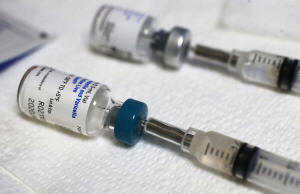Fifteen cases of measles reported in small West Texas county with high
rate of vaccine exemptions
 Send a link to a friend
Send a link to a friend
 [February 11, 2025]
By SEAN MURPHY and DEVI SHASTRI [February 11, 2025]
By SEAN MURPHY and DEVI SHASTRI
Fifteen measles cases — mostly in school-aged children — have been
confirmed in a small county in West Texas with one of the highest rates
of vaccine exemptions in the state.
South Plains Public Health District Director Zach Holbrooks said Monday
that his department was first notified in late January about the first
two cases in Gaines County, which he said were “two children who had
seen a physician in Lubbock.”
Some of the cases appear to be connected to private religious schools in
the district, said Holbrooks, who cautioned that the investigation is
ongoing.
“I wouldn’t say they’re all connected, but our teams are looking into
exposure sites and the background of those cases," he said.
Local health officials set up a drive-through vaccination clinic last
week and are offering screening services to residents.
The U.S. saw a rise in measles cases in 2024, including an outbreak in
Chicago that sickened more than 60. This month, health officials in
metro Atlanta are working to contain a measles case that spread to two
unvaccinated family members.

Texas law allows children to get an exemption from school vaccines for
reasons of conscience, including religious beliefs. The percentage of
kids with exemptions has risen over the last decade from .76% in 2014 to
2.32% last year, according to Texas Department of State Health Services
data.
Gaines County has one of the highest rates in Texas of school-aged
children who opt out of at least one required vaccine: Nearly 14% of
children from kindergarten through grade 12 had an exemption in the
2023-24 school year, which is more than five times the state average of
2.32% and beyond the national rate of 3.3%.
But the number of unvaccinated kids in the county is likely
significantly higher, DSHS spokeswoman Lara Anton said, because Gaines
County has many children who are homeschooled and whose data would not
be reported.
[to top of second column]
|

Measles and tetanus vaccine vials are ready to be administered at
the Dallas County Health & Human Services immunization clinic in
Dallas, on March 8, 2019. (Vernon Bryant/The Dallas Morning News via
AP)
 The measles, mumps and rubella
vaccines is a two-shot series: The first is recommended at 12 to 15
months old and second between 4 to 6 years old. The vaccine is
required to attend most public schools in the U.S.
But vaccination rates have declined nationwide since the COVID-19
pandemic and most states are below the 95% vaccination threshold for
kindergartners — the level needed to protect communities against
measles outbreaks. Lawmakers across the country have proposed
various vaccine requirement changes at a time when anti-vaccine
activist Robert F. Kennedy Jr. is awaiting confirmation as the
secretary of Health and Human Services.
One of the early Gaines County cases traveled to neighboring New
Mexico while they were still infectious, Anton said, but there were
no immediate reports of infection. New Mexico Department of Health
spokesman Robert Nott said the agency has been in communication with
Texas officials but there was no known exposure to measles in his
state.
“We're going to watch this very closely,” Nott said.
Two cases of measles were reported in early January in the Houston
area, but Holbrooks said the West Texas cases don't appear to be
connected.
Measles is a highly contagious virus that can survive in the air for
up to two hours. Up to 9 out of 10 people who are susceptible will
get the virus if exposed, according to the U.S. Centers for Disease
Control and Prevention. Before the vaccine was introduced in 1963,
the U.S. saw some 3 million to 4 million cases per year. Now, it's
usually fewer than 200 in a normal year.
All contents © copyright 2025 Associated Press. All rights reserved
 |